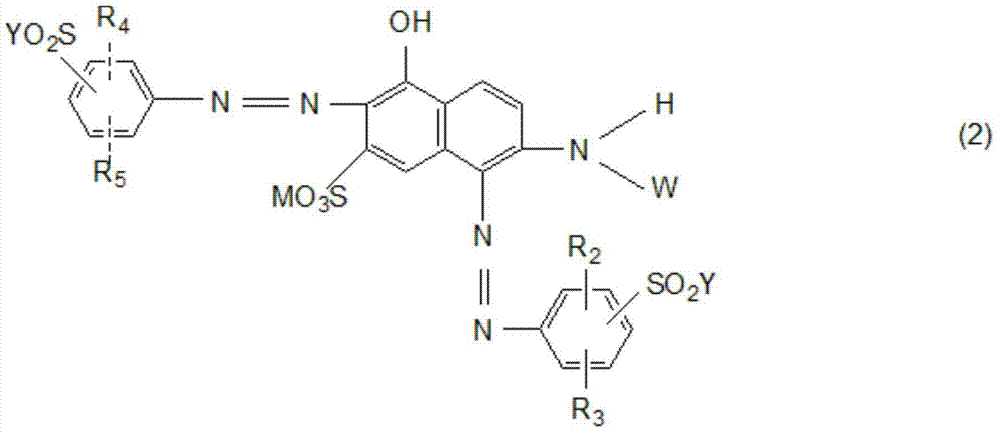Dark colored reactive dye with high fixation rate
A reactive dye and deep black technology, applied in organic dyes, dyeing methods, textiles and papermaking, etc., can solve problems affecting economic benefits, dye residues, and high chroma of dyeing residues
- Summary
- Abstract
- Description
- Claims
- Application Information
AI Technical Summary
Problems solved by technology
Method used
Image
Examples
Embodiment 1
[0051] Mix 0.1mol of para-ester (compound 01) and 0.15mol of hydrochloric acid, add 350g of ice-water mixture, beat for 30min, add 30% NaNO dropwise from the liquid surface at 0~5℃ 2 Solution 0.1mol, keep NaNO during dropwise addition and reaction 2 excess. After diazotization to the end point, excess NaNO 2 Destroy with sulfamic acid.
[0052] Add 0.1mol-amino-8-naphthol-3,6-disulfonic acid (H acid) solution to the above diazonium salt, and carry out acidic coupling at 5-8°C. After the reaction is completed, add 0.1 mol of 2.4-bis(β-hydroxyethylsulfonyl sulfate) aniline diazonium salt dropwise to the above-mentioned acidic coupling monoazo dye reaction solution, and maintain 10°C and PH6~6.5 to react to the end . The navy blue component dye 101 was obtained after membrane separation to remove salt and spray drying.
Embodiment 2
[0054] Add 15g of sodium methanesulfonate to 10% J acid solution (0.1mol), and react at below 50°C for 4 hours to obtain 2-sulfomethylamino-5-naphthol-7-sulfonic acid solution. Add 0.1 mol para-ester diazonium hydrochloric acid solution to the above coupling components, control pH ≤ 2, and couple at 0-5°C until the reaction is complete. Add 0.2mol para-ester diazonium salt solution dropwise to the above-mentioned primary coupling solution, and gradually increase the pH to 6-6.2 at room temperature until the reaction is complete. Salt out, dry and pulverize to get the yellow component dye 301.
Embodiment 4
[0056] 45 parts of dye (101), 15 parts of dye (202), 12 parts of dye (301) and 10 parts of naphthalenesulfonic acid formaldehyde condensate are mixed in a mixing tank as dry powder, or dissolved together and then spray-dried to obtain black dyed cotton as dark black. It has good dyeing performance and satisfactory color fastness.
PUM
 Login to View More
Login to View More Abstract
Description
Claims
Application Information
 Login to View More
Login to View More - R&D
- Intellectual Property
- Life Sciences
- Materials
- Tech Scout
- Unparalleled Data Quality
- Higher Quality Content
- 60% Fewer Hallucinations
Browse by: Latest US Patents, China's latest patents, Technical Efficacy Thesaurus, Application Domain, Technology Topic, Popular Technical Reports.
© 2025 PatSnap. All rights reserved.Legal|Privacy policy|Modern Slavery Act Transparency Statement|Sitemap|About US| Contact US: help@patsnap.com



